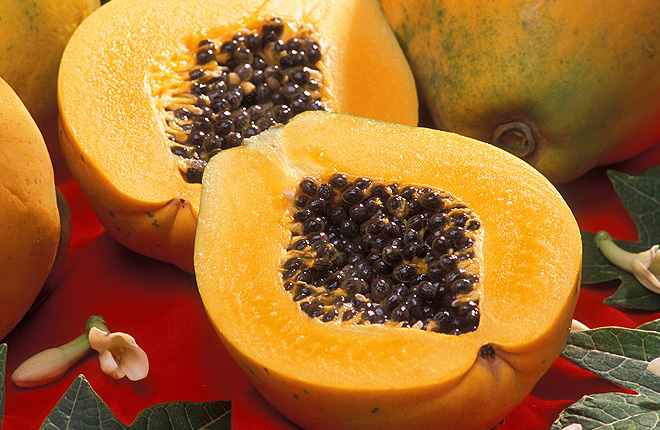Algae + Papaya = Biofuel
There was a time when a green mat of algae was little more than pond scum—but no longer. Now, thanks to advances in science and technology, these microscopic plants are considered promising natural sources of oil that can be converted to biodiesel fuel.
At the Daniel K. Inouye U.S. Pacific Basin Agricultural Research Center in Hilo, Hawaii, Agricultural Research Service (ARS) plant pathologist Lisa Keith has spent the past 5 years fine-tuning conditions under which Chlorella protothecoides algae can be coaxed into producing oil from discarded papayas and other unmarketable crops or byproducts, like glycerol. The effort is part of a zero-waste system being championed and supported by the Hawaii Department of Agriculture (HDOA) to ease the Island State’s reliance on imported oil for its fuel and energy needs.
According to the Hawaii Clean Energy Initiative, a partnership between Hawaii and the U.S. Department of Energy, imported oil supplies 90 percent of Hawaii’s energy—a dependency subject to fluctuating oil prices and availability, which the state hopes to diminish by 2045 by developing clean, renewable energy resources.
“The goal of the zero-waste approach is to make agriculture more profitable and to address food- and energy-security issues in Hawaii,” says Keith, with the ARS center’s Tropical Plant Genetic Resources and Disease Research Unit. To accomplish this, the HDOA’s Agribusiness Development Corporation awarded a $1.6 million grant in 2014 to the ARS center in support of Keith and colleagues’ efforts to scale up the system.
Keith’s research utilizes specialized vats called bioreactors, which “will allow us to grow 150 liters—approximately 40 gallons—of algae. That’s at least 15 times more than we have grown previously,” says Keith, who is collaborating with other scientists from the ARS center and the University of Hawaii.
The team plans to use UTEX 249, a top-performing strain of C. protothecoides that can store as much as 60 percent its cellular weight in lipids when grown, in the absence of sunlight, on a diet of 35 percent papaya juice.
“While nearly all algae are capable of using energy from light to produce organic molecules from carbon dioxide and water, some algae, including C. protothecoides, can also absorb organic molecules, such as sugars, from sources such as papaya juice,” Keith explains. “This is the process we utilized for the zero-waste system,” details of which are published in the August 2015 issue of Algal Research.
In addition to sugar, papaya juice contains carbon, a critical but costly component of current algal-based methods of producing oil for conversion into biodiesel. The zero-waste system only uses unmarketable papayas, which account for 35 percent of Hawaii’s nearly 25-million-pound crop and represent a substantial revenue loss for growers there.
Fortunately, the algae’s fondness for the fruit’s sugar and carbon might offer a way to recoup some of those losses. Another anticipated benefit, besides “home-grown” biodiesel, is a new, low-cost source of animal feed in the form of algal meal, the protein remains of C. protothecoides once its oil has been extracted to make fuel.
“One idea is to incorporate this material into fish feed for commercial freshwater and marine operations,” says Keith. “As the scale-up for this project proceeds, we will begin to accumulate enough raw materials to begin fish-feeding trials.”—By Jan Suszkiw, ARS Office of Communications.
“Algae + Papaya = Biofuel” was published in the April 2016 issue of AgResearch Magazine.
Key Facts
- Some algae produce oil that can be made into biodiesel.
- The algae grow well on a diet of 35 percent papaya juice.
- This research provides a use for damaged papayas.
Full Story







